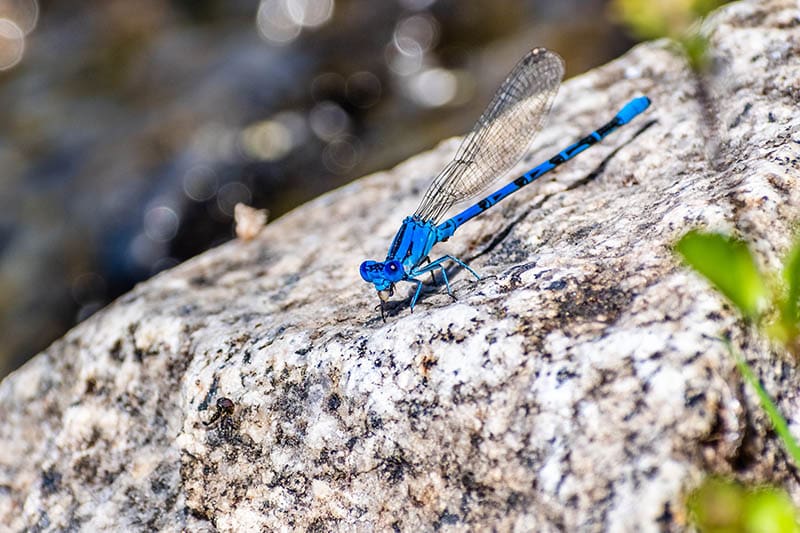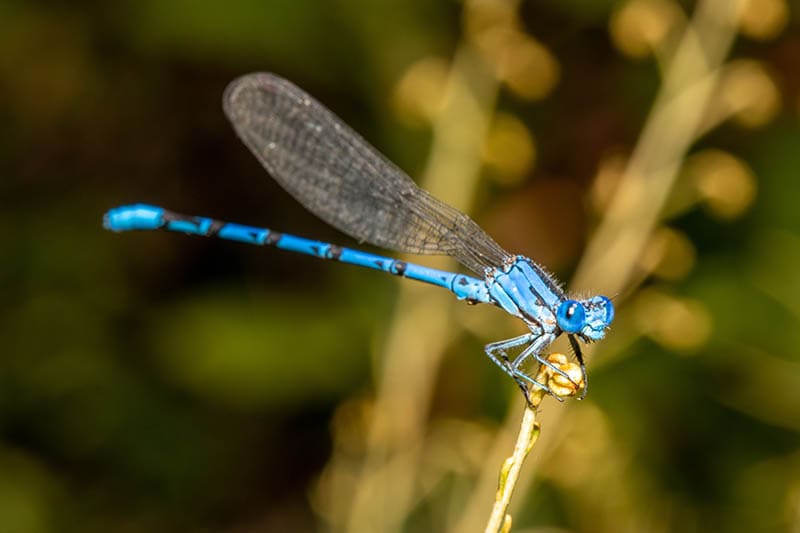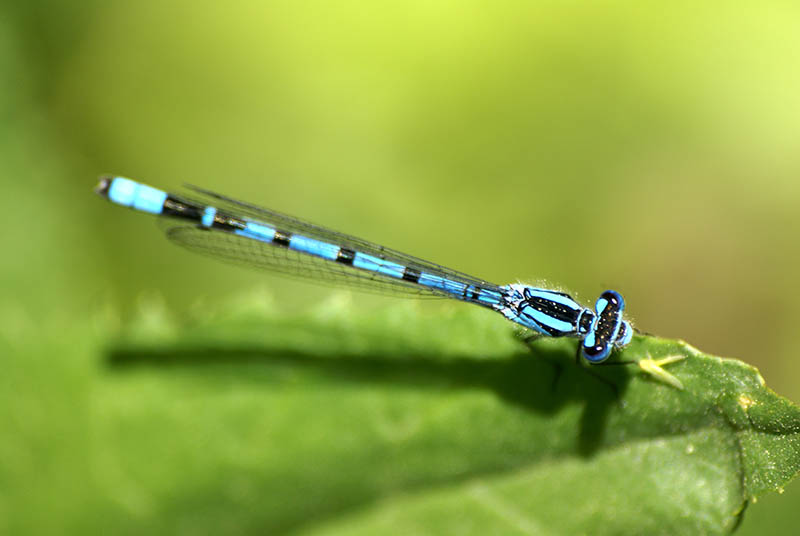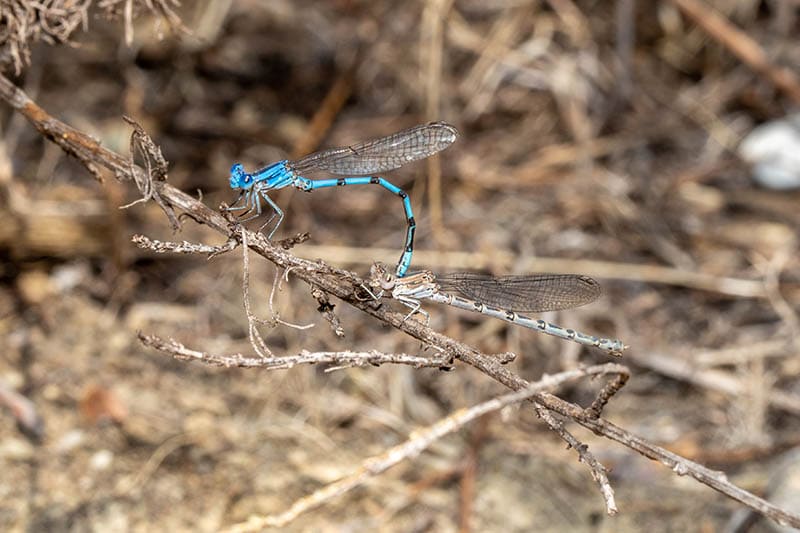What Is the State Insect of Nevada? How Was It Decided?
-
Jeff Weishaupt
- Last updated:

The state insect of Nevada has been the vivid dancer damselfly (Argia vivida) since 2009. It was decided in a school contest held in Las Vegas. The fourth graders of the John R. Beatty Elementary school chose this rich blue insect as it resembles Nevada’s official colors.
The bill to make the vivid dancer the official insect was approved by the state’s assembly and senate. Finally, Governor Jim Gibbons signed Senate Bill 166, making many students happy. You can find the vivid dancer mentioned as the state’s official insect in the Nevada Revised Statutes, Title 19, Chapter 235, Section 235.062.
The vivid dancer is one of the hundred damselfly species found across the US. It is widespread near Nevada’s ponds, particularly in late August. Let’s explore why the vivid dancer is honored as Nevada’s official insect.
Vivid Dancer Damselfly: A Brief Overview
Vivid dancers are blue-and-black small damselflies. These are active insects that are spotted flying everywhere in the US. They are harmless to humans, but when it comes to other small flying insects, they can be fierce predators.
You can easily identify a vivid dancer damselfly by its appearance. They look like a dragonfly but have a striking electric blue color.
The adult males have unique dark stripes on their thorax in the shape of an urn (wide from the top and narrower from the bottom). As the stripe goes halfway down, it turns into a fine line. Their abdomen is blue with triangle spots and black rings. However, the adult female vivid dancers are brown or tan instead of blue.

Vivid Dancer Damselfly: Taxonomic Hierarchy
The vivid dancer damselfly is closely related to the dragonfly. They are present in the order Odonata, which includes all the dragonflies and damselflies species found worldwide. Here is a detailed taxonomic hierarchy of these insects:
| Kingdom: | Animalia |
| Phylum: | Arthropoda |
| Subphylum: | Hexapoda |
| Class: | Insecta |
| Order: | Odonata |
| Suborder: | Zygoptera (Damselflies) |
| Family: | Coenagrionidae (Narrow-winged Damselflies) |
| Genus: | Argia |
| Species: | Vivida |
Vivid Dancer Damselfly: How Was It Decided As Nevada’s Official Insect?
A contest was organized in Nevada in 2009 that included the Gifted and Talented Education (GATE) and fourth-grade classrooms to select the state’s official insect. Nevada was one of the eight states with no official insect at that time. The contest was accessible to all homeschooled, public, and private students.
These classrooms were asked to nominate an insect and submit a single-page research essay in its support. A total of 74 classrooms participated in the contest, representing 57 schools in the state. The winners were the fourth graders from John R. Beatty Elementary School on Hidden Palms Parkway.
On March 4, 2009, Senator Joyce Woodhouse presented Senate Bill 166 in the State Senate to recognize vivid dancer damselfly as Nevada’s official insect. Soon, Governor Jim Gibbons signed the bill, making Nevada the 43rd state with an official insect. The bill was already approved by the state’s assembly and senate.
Three students from John R. Beatty Elementary School’s classroom testified for the vivid dancer in the legislative hearings. They told the legislators that they chose the damselfly because the insect is widespread throughout the state, and its colors resemble Nevada’s official colors.

Vivid Dancer Damselfly: Range, Habitat, and Diet
The beauty of the vivid dancer damselfly isn’t limited to their complimentary colors. Their distinctive range, habitat, and diet also make them the best choice as Nevada’s official insect. Here is a quick overview:
Range
The vivid dancer damselflies are prevalent throughout the state. They are also seen traveling to Eastern British Columbia, Alberta, and South to Texas, Baja California, and New Mexico. These striking damselflies are also spotted in Idaho. The adult flight season starts on April 15 and continues till October 25.
Habitat
Vivid Dancer damselflies are primarily seen in spring-fed ponds and streams. They stay close to the place they were born, which can be arid or semi-arid areas. The species has the most prolonged flight season among the dragonflies and damselflies.
Diet
The babies or nymphs of damselflies eat larvae of many aquatic insects, including mayflies, mosquitoes, and others. The adults’ diet includes grown-up soft-bodied insects, such as flies, moths, mayflies, and mosquitoes. You may also find them catching on small insects, like aphids, from plants.

Reproduction
The males establish territories near their favorite habitats. To mate, the male grabs the female during the flight. When mating, the male stays attached to their partner while she lays eggs in vegetation. The female vivid dancer damselfly typically oviposits on aquatic plants.
As the eggs hatch, nymphs pass through 10–12 instars or stages during development. When nymphs grow older, they come out of the aquatic habitat and shed their exoskeleton. Once it’s completely shed, the nymph becomes an adult vivid dancer damselfly.
The adults live for multiple weeks and can be seen throughout the warm months. You are likely to spot adult insects near the water habitats.
Are Damselflies Same as Dragonflies?
If you’re not an entomologist, you may not be able to find a clear difference in the appearance of dragonflies and damselflies. However, people who study insects can tell the difference when the two insects land or are not flying.
A dragonfly keeps its wings straight or horizontal like an airplane. On the other hand, a damselfly keeps its wings folded on its back, similar to a butterfly. Also, damselflies are smaller than their counterparts.
Both insects are active hunters. The males choose an ideal perch location that gives them a clear view of the flying insects, including mosquitos. Dragonflies and damselflies love catching and eating mosquitoes and other small flying insects. They scoop their prey with their basket-like legs and eat them with their powerful jaws.
Conclusion
Vivid dancer damselflies are electric blue insects present in abundance across the country. In Nevada, they are seen flying near aquatic habitats, including streams, ponds, and rivers. Vivid dancers live, eat, and reproduce in arid and semi-arid areas.
Because of its color, a group of students considered the vivid dancer damselfly as the official insect of Nevada. Finally, it got recognized on the state level in 2009, and since then, vivid dancers have been the state insect of Nevada.
Damselflies and dragonflies look pretty similar. So make sure you know how to distinguish both when searching for beautiful vivid dancers in Nevada.
Featured Image Credit: Sundry Photography, Shutterstock
Contents
